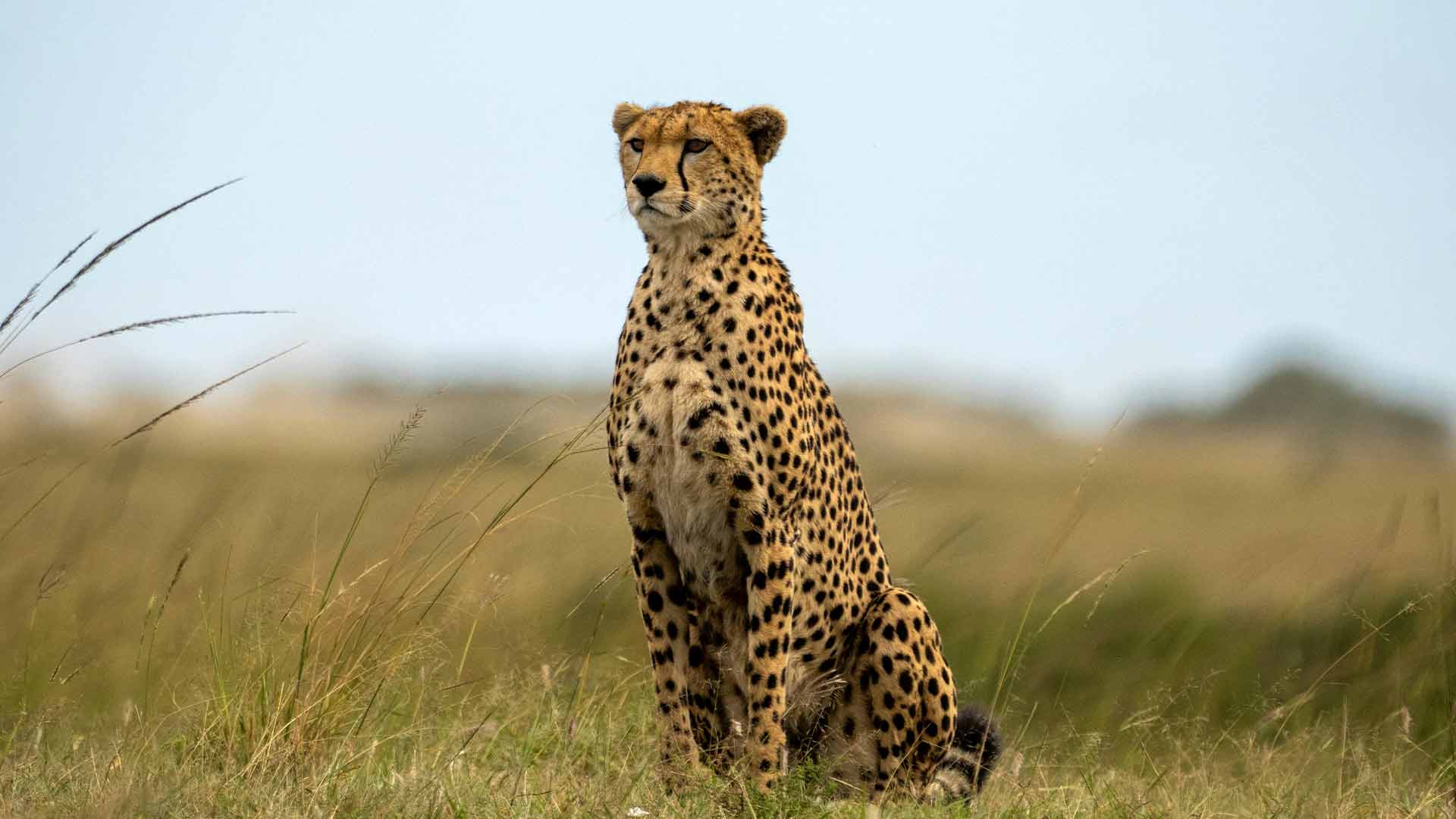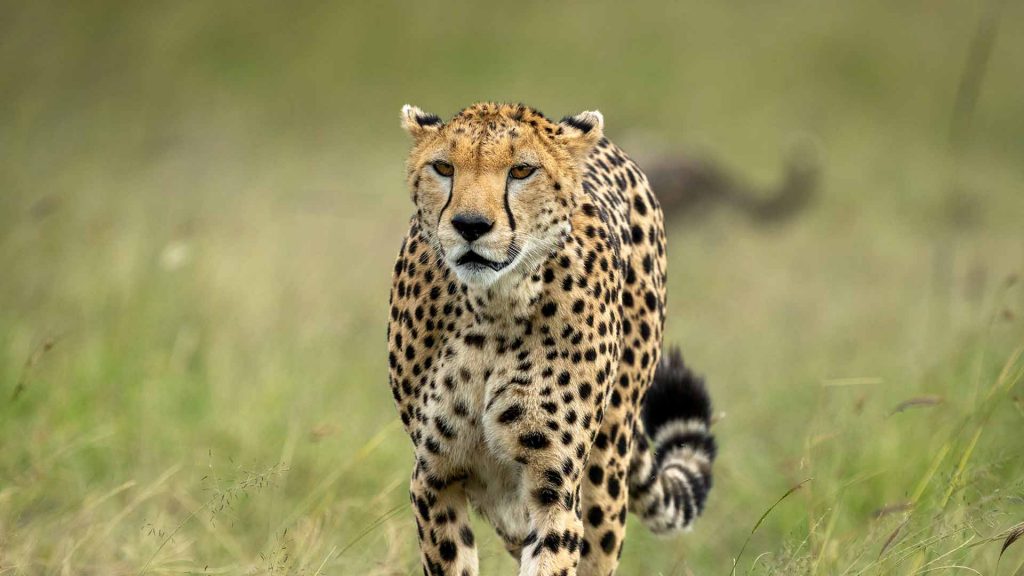Cheetah
The cheetah (Acinonyx jubatus), the fastest land animal, reaches speeds up to 70 mph, making it a marvel of evolutionary design. Discover their behaviour, physical description, habitat, diet, reproduction, and geographical distribution.

Overview
The cheetah, scientifically known as Acinonyx jubatus, is the world’s fastest land animal and an emblem of grace and speed. This majestic big cat is easily recognizable by its slender body, deep chest, spotted coat, and distinctive tear markings on its face. As an apex predator, the cheetah plays a vital role in maintaining the ecological balance within its habitat.
Species in Africa
There are five recognized subspecies of cheetah, four of which are found in Africa:
- Southeast African Cheetah (Acinonyx jubatus jubatus): The most common subspecies, found in countries like South Africa, Namibia, Botswana, and Zimbabwe.
- Northeast African Cheetah (Acinonyx jubatus soemmeringii): Inhabits parts of East Africa, including Ethiopia, South Sudan, and northern Kenya.
- Northwest African Cheetah (Acinonyx jubatus hecki): A critically endangered subspecies found in Algeria, Niger, and Mali.
- Southern Saharan Cheetah (Acinonyx jubatus venaticus): Present in areas of the Sahara Desert and Sahel regions, including countries like Chad and Niger.
Scientific Classification
- Kingdom: Animalia
- Phylum: Chordata
- Class: Mammalia
- Order: Carnivora
- Family: Felidae
- Genus: Acinonyx
- Species: Acinonyx jubatus
Description
Cheetahs are marvels of evolutionary design, built for speed and agility. Their physical adaptations allow them to accelerate from 0 to 60 miles per hour in just a few seconds, making them unparalleled sprinters in the animal kingdom.
Size
Adult cheetahs typically stand about 70 to 90 centimeters (28 to 35 inches) tall at the shoulder, with a body length ranging from 1.1 to 1.5 meters (3.6 to 4.9 feet) and a tail length of 60 to 80 centimeters (24 to 31 inches).
Weight
They weigh between 34 to 54 kilograms (75 to 119 pounds).
Coat
Cheetahs have a short, coarse coat that is tawny or golden-yellow in color with round black spots covering most of the body. Each cheetah’s spot pattern is unique.
Face
They have distinctive black “tear marks” that run from the inner corners of their eyes down to the sides of their mouth, believed to protect their eyes from the sun and aid in hunting by focusing attention on prey.
Limbs and Tail
Cheetahs have long, muscular legs that enable their incredible speed. Their semi-retractable claws provide traction, similar to cleats on a running shoe. The long tail helps them balance and steer during high-speed chases.

Behavior, Diet, Reproduction, and Lifespan
Behaviour
Cheetahs are primarily diurnal, meaning they are active during the day. This behavior helps them avoid larger nocturnal predators such as lions and leopards.
- Hunting: Cheetahs rely on their exceptional speed and keen eyesight to hunt. They typically stalk their prey to within 60-70 meters before launching a sprint, using their agility to trip the prey and deliver a suffocating bite to the throat.
- Social Structure: Unlike many big cats, cheetahs have a relatively loose social structure. Males, often siblings, form small groups called coalitions, which provide better opportunities for defending territories and hunting. Females, on the other hand, are more solitary and only interact with males during mating season or while raising cubs.
Diet
Cheetahs primarily prey on small to medium-sized ungulates such as gazelles, impalas, and springboks. They also hunt smaller animals like hares and birds when larger prey is scarce. Their diet varies depending on the region and availability of prey.
Reproduction and Lifespan
Female cheetahs reach sexual maturity around two years of age. After a gestation period of about 90 to 95 days, the female gives birth to a litter of three to five cubs. Cubs are born blind and helpless, relying entirely on their mother for food and protection.
In the wild, cheetahs typically live for about 10 to 12 years. In captivity, they can live up to 17 years due to better medical care and a controlled environment.
Habitat and Geographical Distribution
Cheetahs are adaptable animals found in a variety of habitats, from open savannas and grasslands to arid regions and dense vegetation.
In Namibia, the country with the largest population of cheetahs, they roam the farmlands and protected areas such as Etosha National Park. Namibia’s diverse landscapes provide ample hunting grounds and shelter for these predators.
In Botswana, cheetahs thrive in the Okavango Delta and the Central Kalahari Game Reserve. These regions offer a mix of open spaces for hunting and wooded areas for shelter, making them ideal habitats for cheetahs.
South Africa is home to cheetahs in reserves like the Kruger National Park, the Kgalagadi Transfrontier Park, and private game reserves. These protected areas are crucial for maintaining healthy cheetah populations by offering controlled environments free from human-wildlife conflict.
Kenya and Tanzania boast significant cheetah populations in iconic reserves such as the Maasai Mara, Serengeti National Park, and Tsavo East and Tsavo West National Park. The vast savannas and seasonal migrations of prey in these regions provide excellent hunting opportunities for cheetahs.
In Ethiopia and Northern Kenya, the Northeast African cheetah can be found in areas like the Awash National Park and the surrounding regions. These areas offer a mix of semi-arid habitats and grasslands that are suitable for cheetah populations.
In Algeria, Niger, and Mali, the critically endangered Northwest African cheetah inhabits the sparse and harsh environments of the Sahara and Sahel regions. These cheetahs have adapted to survive in some of the most extreme conditions on the continent.
Chad hosts the Southern Saharan cheetah in regions such as the Zakouma National Park. These areas provide a unique mix of habitats that support the diverse prey base needed for cheetah survival.
Conservation
Cheetahs face numerous threats, including habitat loss, human-wildlife conflict, and illegal wildlife trade. Conservation efforts are focused on habitat protection, anti-poaching measures, and fostering coexistence between humans and wildlife.
Facts
Interesting facts about The Cheetah.
Cheetahs can reach speeds of up to 60 to 70 miles per hour (97 to 113 kilometers per hour) in short bursts covering distances up to 500 meters (1,640 feet).
Cheetahs have several adaptations for speed, including a lightweight frame, long legs, a flexible spine, and large nasal passages for increased oxygen intake. Their semi-retractable claws provide traction, and their long tail aids in balance and steering during high-speed chases.
Cheetahs communicate using a variety of vocalizations such as chirps, purrs, growls, and hisses. They also use body language, facial expressions, and scent markings to convey information.
The primary threats to cheetahs are habitat loss, human-wildlife conflict, and poaching. Agricultural expansion and urban development reduce their natural habitat, leading to increased conflicts with humans.
Cheetah mothers are highly attentive, moving their cubs to new hiding spots every few days to protect them from predators. They teach their cubs hunting skills and provide food until they are old enough to hunt on their own.
Male cheetahs often form small groups called coalitions, usually consisting of brothers from the same litter. Females are generally solitary except when raising cubs or during mating.
Cheetahs primarily hunt small to medium-sized ungulates such as gazelles, impalas, and springboks. They also eat hares and birds when larger prey is scarce.
In the wild, cheetahs live for about 10 to 12 years, while in captivity, they can live up to 17 years due to better medical care and a controlled environment.
Conservationists use various methods to track cheetah populations, including GPS collars, camera traps, and spoor (track) surveys. These tools help gather data on cheetah movements, behavior, and population dynamics.
Conservation efforts include habitat protection, anti-poaching initiatives, community engagement programs, and maintaining genetic diversity through breeding programs and wildlife corridors.
Other Animals
Explore fauna in Africa.






